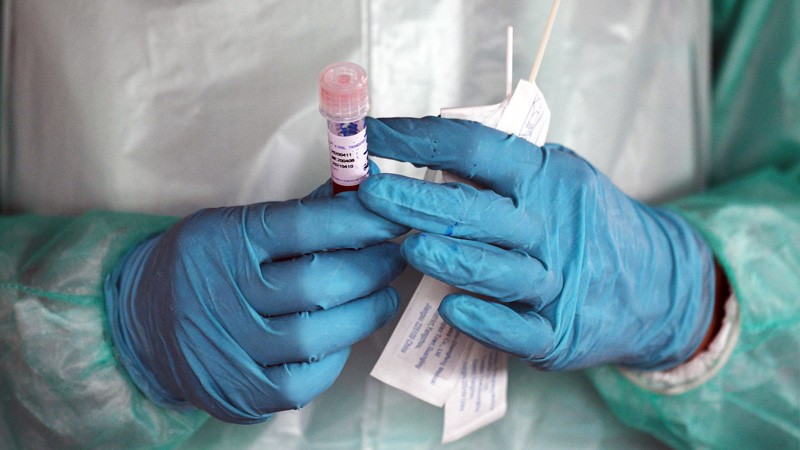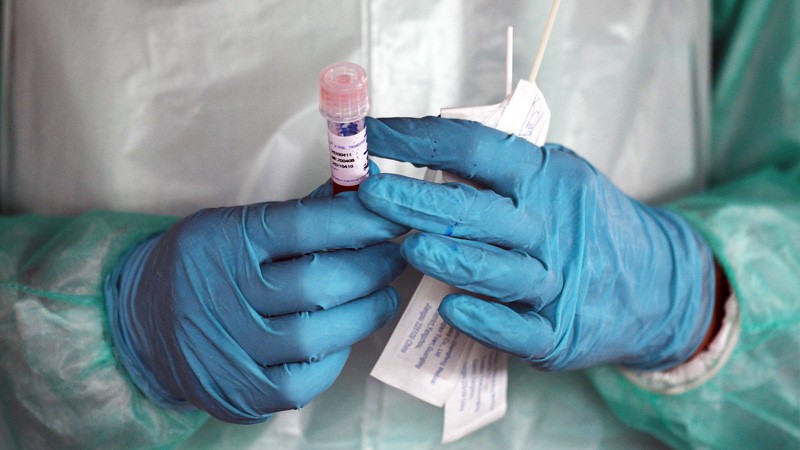
A well being-care employee getting ready to check folks for SARS-CoV-2 holds throat swabs, now a scarce and sought-after useful resource. Credit: Mohd Rasfan/AFP/Getty
Fresh findings about SARS-CoV-2 and the illness it causes.
24 April — Spit could be the solution to testing shortages
An individual’s saliva precisely reveals whether or not they’re contaminated with SARS-CoV-2, a discovering that could make assessments for the virus safer and extra broadly accessible.
The gold-commonplace check for coronavirus an infection requires an extended swab to be rubbed towards the again of the throat. But such swabs are briefly provide, and swabbing can immediate folks to cough or sneeze, doubtlessly launching a barrage of viral particles.
Anne Wyllie at the Yale School of Public Health in New Haven, Connecticut, and her colleagues collected each saliva and throat samples from folks hospitalized with COVID-19 (A. Wyllie et al. Preprint at medRxiv, http://doi.org/ggssqf, 2020). The group’s testing didn’t detect the virus in some sufferers’ throat-swab samples — however did detect it in the similar sufferers’ saliva samples. Saliva testing additionally confirmed that two well being-care staff who felt high-quality and had adverse throat assessments have been truly contaminated.
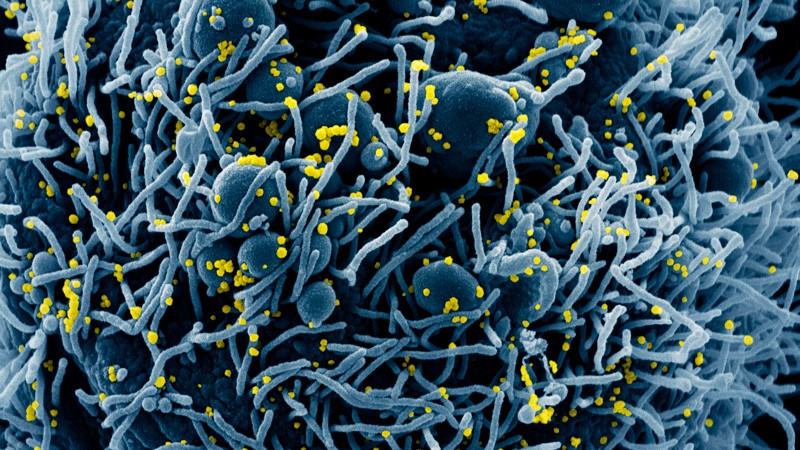

A human cell (blue; artificially colored) contaminated with SARS-CoV-2 (yellow).Credit: NIAID/NATIONAL INSTITUTES OF HEALTH/SPL
23 April — Intensive testing finds a small city’s many silent infections
A big proportion of folks with COVID-19 haven’t any signs, in accordance to analysis in a small Italian city.
On 21 February, the city of Vo’ reported Italy’s first COVID-19 loss of life, main authorities to ban motion in the city and finish public providers and business actions there for 2 weeks. Andrea Crisanti at Imperial College London and his colleagues swabbed virtually each resident of Vo’ for viral RNA at the starting and finish of the lockdown.
The group discovered that some 43% of the folks contaminated with SARS-CoV-2 in the city reported no fever or different signs (E. Lavezzo et al. Preprint at medRxiv http://doi.org/ggsmcj; 2020). The researchers noticed no statistically important distinction in potential infectiousness between those that reported signs and those that didn’t.
Asymptomatic and pre-symptomatic people have a key function in COVID-19 transmission, which makes it tough to management the illness with out strict social distancing, the authors say.
22 April — A vaccine candidate reveals early success in an animal trial
An experimental vaccine protects monkeys from an infection with the virus that causes COVID-19.
A group led by Chuan Qin at the Peking Union Medical College in Beijing injected rhesus macaques (Macaca mulatta) with three doses of a vaccine comprised of chemically inactivated particles of SARS-CoV-2 (Q. Gao et al. Preprint at bioRxiv http://doi.org/dskt; 2020). Eight monkeys have been then deliberately uncovered to the virus.
All 4 monkeys given a excessive dose of the vaccine had no detectable virus of their throat or lungs seven days after publicity. Monkeys that acquired a decrease dose of vaccine confirmed some indicators of coronavirus an infection — however their ranges of virus have been a lot decrease than in uncovered animals that acquired no vaccine. This month, the firm growing the vaccine acquired approval to begin human security trials on it.
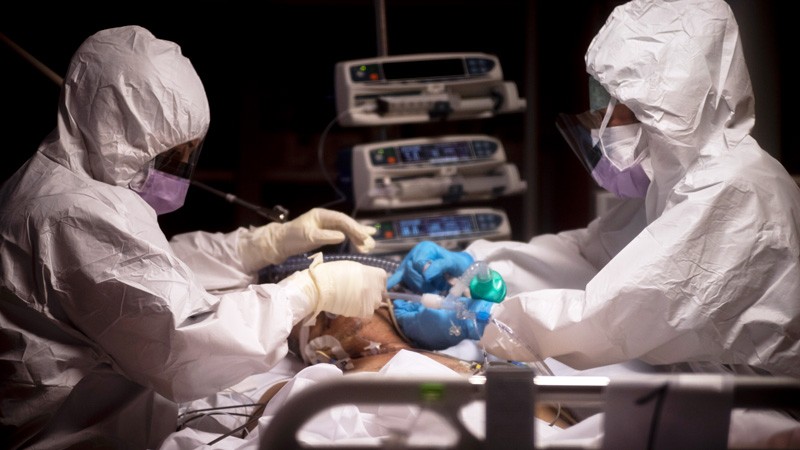

A person with COVID-19 is handled at an intensive care unit in Rome.Credit: Antonio Masiello/Getty
20 April — How Hong Kong stemmed viral unfold with out harsh restrictions
Hong Kong slowed the unfold of SARS-CoV-2 by means of a mixture of intensive surveillance, quarantining and social distancing with out counting on extreme measures used elsewhere.
In January, the authorities in Wuhan, the place the coronavirus outbreak started, halted journey out of the metropolis in an try to management the unfold of the virus that causes COVID-19. But Hong Kong relied on a programme that included widespread testing, quarantining of those that had been in touch with contaminated folks, and distancing measures corresponding to faculty closures. When Peng Wu at the University of Hong Kong and her colleagues surveyed residents in early March, 99% stated they wore a masks in public and 85% stated they prevented crowds (B. J. Cowling et al. Lancet Public Health http://doi.org/dsfw; 2020).
The mixture of public behavioural adjustments and authorities measures saved the virus’s unfold comparatively low in Hong Kong throughout the interval to the finish of March, the group discovered.
17 April — Vaccine from viral spikes holds promise
A key portion of a coronavirus protein could type the foundation of a protected and efficient vaccine.
Coronavirus particles bristle with spiny ‘spike proteins’. A portion of the spike known as the receptor-binding area acknowledges and attaches to a molecule discovered on the floor of many human cells, permitting the viral particle to achieve entry into these cells.
Hyeryun Choe and Michael Farzan at the Scripps Research Institute in Jupiter, Florida, and their colleagues immunized rats with fragments of the spike’s binding area (B. D. Quinlan et al. Preprint at bioRxiv, http://doi.org/ggrs5t; 2020). In response, the rodents’ immune programs made antibodies that may acknowledge coronavirus and forestall it from infecting cells.
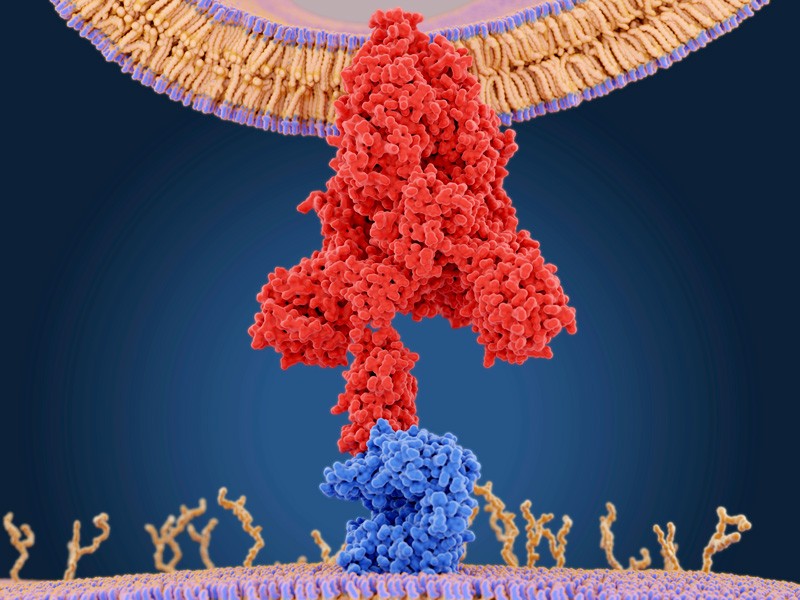

One of the spike proteins (pink) on a SARS-CoV-2 particle grabs a receptor on a cell.Credit: SPL
Further experiments instructed that these antibodies are unlikely to make host cells extra inclined to coronavirus an infection — one of the major security considerations for vaccines.
16 April — Ski buffs helped to seed coronavirus in Iceland
Holidaymakers coming back from ski journeys to the Alps helped to convey the coronavirus to Iceland.
In late January, Kari Stefansson at deCODE Genetics-Amgen in Reykjavik and his colleagues started testing for SARS-CoV-2 amongst Iceland residents at excessive danger of publicity to the virus, corresponding to travellers to China (D. F. Gudbjartsson et al. N. Engl. J. Med. http://doi.org/ggr6wx; 2020). Some 13% of the 9,199 folks examined by early April have been contaminated. The group sequenced viral RNA from individuals who examined optimistic and located that some of the strains had in all probability originated in Austria or Italy, which each have Alpine ski resorts.
Tests in the second half of March on greater than 2,000 randomly chosen people discovered that solely zero.6% have been contaminated. The researchers say their evaluation means that measures to include the virus by means of testing, contact tracing and quarantining have been profitable in Iceland.
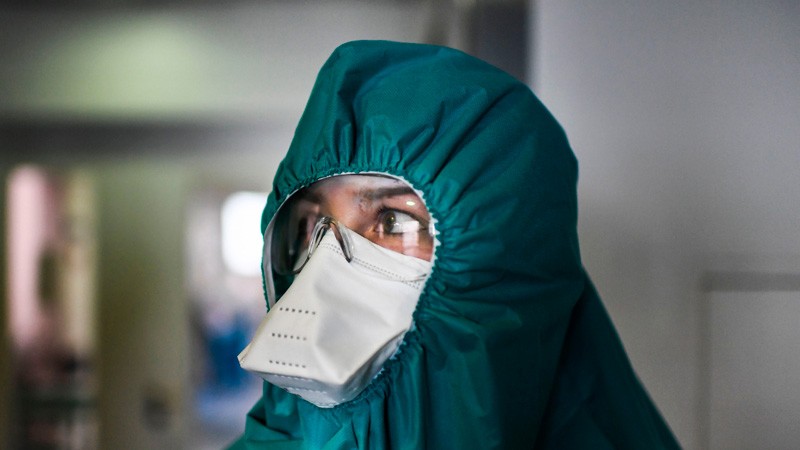

A healthcare employee dressed for a shift in the COVID-19 intensive care unit in Lisbon.Credit: Patricia De Melo Moreira/AFP/Getty
15 April — Relief from social distancing could unleash the virus anew
Cases of COVID-19 are probably to surge after present social-distancing measures are eased, in accordance to fashions.
Yonatan Grad, Marc Lipsitch and their colleagues at the Harvard T.H. Chan School of Public Health in Boston, Massachusetts, modelled the unfold of coronaviruses in locations which have temperate climates, corresponding to the United States. The outcomes helped the group to predict the unfold of SARS-CoV-2, the coronavirus that causes COVID-19 (S.M. Kissler et al. Science http://doi.org/drz3; 2020).
The researchers discovered that if SARS-CoV-2 spreads extra effectively in some seasons than in others — as influenza virus does, for instance — the peak quantity of COVID-19 instances after social distancing ends could be bigger than the peak quantity with none social distancing in any respect. That’s as a result of distancing measures go away a excessive proportion of folks inclined to an infection, main to a spike of illness if viral transmission ramps up late in the yr.
If human immunity to SARS-CoV-2 wanes over the course of a couple of years, the virus is probably going to trigger repeated outbreaks in wintertime, the authors say.
15 April — Common sequencing approach could pace giant-scale analysis
An ordinary genomic-evaluation technique that may sequence tens of 1000’s of DNA samples in a day has been tailored to detect the virus that causes COVID-19.
In a testing protocol proposed by Jonathan Schmid-Burgk at the Broad Institute of MIT and Harvard in Cambridge, Massachusetts, and his group, each pattern being examined for SARS-CoV-2 would be tagged with a novel DNA sequence that may function a organic barcode (J. L. Schmid-Burgk et al. Preprint at bioRxiv, http://doi.org/drzc; 2020). High-speed sequencing devices frequent in analysis laboratories round the world could then be used to analyse as many as 100,000 DNA samples at one time.
The authors anticipate that if scientific testing validates the technique, then thousands and thousands of samples could be analysed per day at every sequencing website — a much more environment friendly output than that of present testing methods.
Correction: An earlier model didn’t embody the title of the paper’s corresponding creator, Jonathan Schmid-Burgk.
10 April — A viral enzyme’s construction factors to potential medication
Scientists have detailed the crystal construction of one of SARS-CoV-2’s key proteins, an enzyme known as a protease that the virus wants to replicate inside our cells.
Hualiang Jiang, Zihe Rao and Haitao Yang at ShanghaiTech University in China and their colleagues deposited the construction in a protein knowledge financial institution two months in the past, and have since used it to assist them determine compounds that inhibit the protease (Z. Jin et al. Nature https://doi.org/10.1038/s41586-020-2223-y; 2020). The group’s screening revealed a number of highly effective viral inhibitors, together with ebselen, whose security has already been examined in folks.
These inhibitors work by infiltrating a hole in the protease. Proteases present in different coronaviruses have the same hole, elevating hopes that a single compound may assist to deal with all kinds of ailments attributable to coronaviruses.
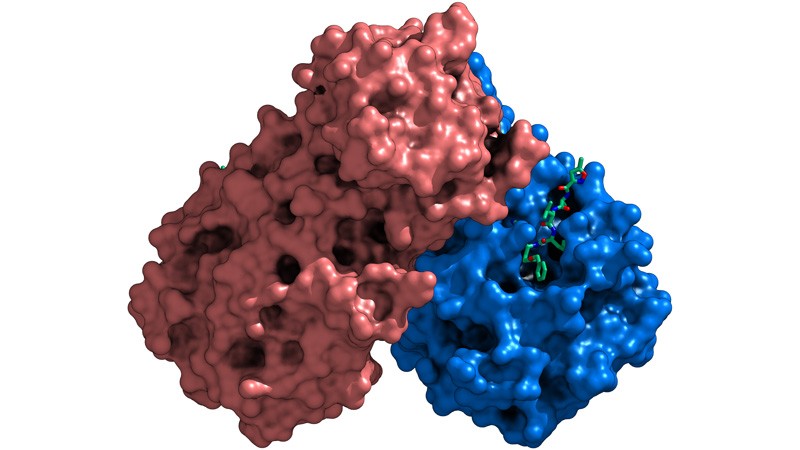

One of SARS-CoV-2’s key enzymes consists of two models (blue and pink; artist’s impression) and features a hole the place candidate medication (inexperienced) can bind the enzyme.Credit: Z. Jin et al./Nature
9 April — Absent antibodies recommend thriller immune response
After recovering from an infection with SARS-Cov-2, many individuals have excessive ranges of antibodies towards the virus. But a current research finds that in some recovered sufferers, such antibodies are current at very low ranges — and in some instances are undetectable.
When a international microbe intrudes on the physique, the immune system normally makes proteins known as antibodies that assist to battle off the invader. A group led by Jinghe Huang and Fan Wu at Fudan University in Shanghai, China measured antibodies to the novel coronavirus in 175 volunteers who had recovered from delicate infections (F. Wu et al. https://www.medrxiv.org/content material/10.1101/2020.03.30.20047365v1, 2020). About 30% of the volunteers — and particularly these beneath the age of 40 — by no means developed excessive ranges of SARS-CoV-2 antibodies, suggesting that different immune responses helped rid them of their infections.
eight April — Viral load soars as contaminated folks begin feeling sick
Viral RNA ranges are highest in folks with COVID-19 quickly after their signs seem, in accordance to two separate analysis groups.
Kwok-Yung Yuen at The University of Hong Kong–Shenzhen Hospital, China, and his colleagues analysed saliva samples coughed up by 23 folks contaminated with SARS-CoV-2. The group discovered that research individuals’ viral concentrations peaked shortly after they began feeling sick, and started declining about one week after the peak.
The extra viral RNA detected in an individual’s physique, the extra they excrete when coughing or sneezing. The authors say that the excessive ranges of SARS-CoV-2 particles detected at the onset of signs recommend that the virus can be transmitted simply between folks, even when signs are comparatively delicate (Okay. Okay.-W. To et al. Lancet Infect. Dis. http://doi.org/ggp4qx; 2020).
The outcomes are in keeping with one other research of nostril and throat swabs from 18 folks with COVID-19. The concentrations of viral RNA in the 17 symptomatic sufferers have been related to that in the one asymptomatic affected person (L. Zou et al. N. Engl. J. Med. http://doi.org/ggmzsp; 2020).
However, one other research discovered that folks with milder COVID-19 signs on admission to hospital had a lot decrease concentrations of viral RNA than did these with extra extreme signs (Y. Liu et al. Lancet Infect. Dis. http://doi.org/dqrr; 2020). Wei Zhang at The First Affiliated Hospital of Nanchang University, China, Leo Poon at the University of Hong Kong, and their colleagues say the findings recommend that viral RNA concentrations could predict whether or not contaminated folks will develop extra extreme signs.
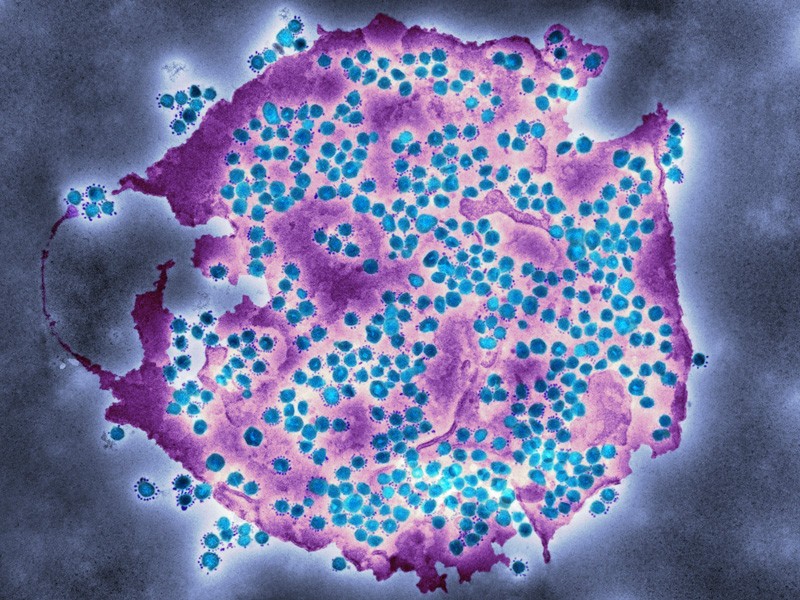

Particles (blue) of the virus that causes COVID-19.Credit: NATIONAL INFECTION SERVICE/SPL
7 April — A comparability finds refined variations between assessments for the COVID-19 virus
Doctors depend on a check known as quantitative reverse-transcription polymerase chain response (qRT-PCR) to decide whether or not an individual is contaminated with SARS-CoV-2. A group led by Nathan Grubaugh at Yale School of Public Health in New Haven, Connecticut, in contrast 9 broadly used variations of the check and located that every one of them reliably detect the virus (C. B. F. Vogels et al. Preprint at medRxiv https://www.medrxiv.org/content material/10.1101/2020.03.30.20048108v1; 2020).
But the researchers additionally discovered that some assessments — together with one made by the US Centers for Disease Control and Prevention, one other developed at Hong Kong University, and a 3rd from Charité–Universitätsmedizin Berlin — carried out finest when it got here to detecting low ranges of the virus in samples.
5 April — Bats harbour a pool of coronaviruses associated to pandemic wrongdoer
Viruses carefully associated to SARS-CoV-2, the virus inflicting the COVID-19 pandemic, have been circulating in horseshoe bats, prepared to bounce to people, for many years — and perhaps even longer.
David Robertson at the University of Glasgow, UK, and his colleagues analysed the RNA of 68 coronaviruses, together with SARS-CoV-2 and the virus that causes extreme acute respiratory syndrome, or SARS (M. F. Boni et al. Preprint at bioRxiv https://doi.org/10.1101/2020.03.30.015008; 2020). This evaluation reveals that horseshoe bats (Rhinolophus spp.) host an increasing lineage of viruses that, like SARS-CoV-2, can infect people. The group estimates that the ancestor of SARS-CoV-2 cut up 40 to 70 years in the past from the carefully associated bat virus RaTG13. Though the two viruses are extremely related genetically, RaTG13 doesn’t infect people.
The evaluation additionally means that viruses in the lineage are prepared to bounce to people straight from bats. But SARS-CoV-2 might need first hopped to one other species that people are extra uncovered to, reasonably than spreading straight from bat to human.
three April — Masks could reduce unfold of COVID-19 virus
Surgical face masks successfully block the unfold of seasonal coronaviruses in respiratory droplets, suggesting that masks could forestall transmission of SARS-CoV-2.
Seasonal coronaviruses are one trigger of the frequent chilly. Benjamin Cowling at the University of Hong Kong and his colleagues had sick volunteers who have been contaminated with seasonal coronaviruses sit in an enclosed sales space and place their faces in a sampling gadget, known as the Gesundheit-II, that captures airborne particles (N. H. L. Leung et al. Nat. Med. https://doi.org/10.1038/s41591-020-0843-2; 2020).
The scientists detected coronavirus RNA in each coarse droplets and finer ‘aerosol’ droplets emitted by volunteers who weren’t sporting masks. Mask decreased detection of viral RNA in each sorts of droplet. Larger particles are carried by sneezes and coughs, whereas exhaled breath can unfold aerosol droplets, which have a diameter of 5 micrometres or much less.
The authors say that surgical masks scale back transmission of not solely seasonal coronaviruses, but in addition influenza.
Correction: An earlier model of this text stated masks decreased detection of viral DNA.
1 April — Antibodies from llamas assist to foil the COVID-19 virus
Antibodies from llamas (Lama glama) could assist in the battle towards a number of coronaviruses that infect people.
A group led by Bert Schepens and Xavier Saelens of the VIB life-sciences institute in Ghent, Belgium, and Jason McLellan of the University of Texas at Austin has remoted two llama antibodies that bind the ‘spike’ proteins that coronaviruses use to enter cells (D. Wrapp et al. Preprint at bioRxiv https://doi.org/10.1101/2020.03.26.010165; 2020). One antibody neutralized the coronavirus answerable for Middle East respiratory syndrome (MERS); the second mopped up the extreme acute respiratory syndrome (SARS) coronavirus.
Fusing the SARS antibody from a llama with an antibody from a human yielded a hybrid that neutralized the virus answerable for COVID-19. The knowledge recommend that such antibodies could be helpful in combating coronavirus epidemics
30 March — Debilitated sufferers rally after dose of survivors’ blood
People significantly sick with COVID-19 skilled placing enchancment after receiving infusions of blood from illness survivors, in accordance to two separate analysis groups.
Both groups extracted antibody-laden plasma — a part of blood — from individuals who’d recovered from COVID-19.
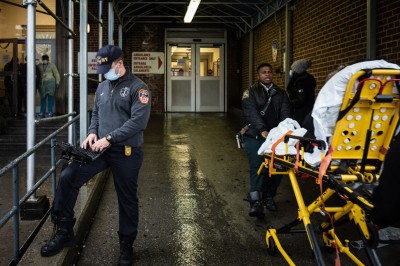
Xiaoming Yang at the National Engineering Technology Research Center for Combined Vaccines in Wuhan, China, and his colleagues gave the plasma to ten severely sick folks. By the sixth day after the therapy, the virus that causes COVID-19 was undetectable in seven of the ten. The recipients skilled no important negative effects (Okay. Duan et al. Preprint at medRxiv http://doi.org/dqrs; 2020).
A bunch led by Lei Liu at Shenzhen Third People’s Hospital in China gave survivors’ plasma to 5 “critically ill” folks (C. Shen et al. J. Am. Med. Assoc. http://doi.org/dqn7; 2020). Symptoms dwindled in all 5; inside ten days of receiving the plasma, three recipients not wanted ventilators.
Other researchers would really like to attempt such transfusions to deal with well being staff who’ve been straight uncovered.
27 March — Viral proteins level to potential remedies
An inventory of the human proteins affected by the SARS-CoV-2 virus provides a information to potential remedies for contaminated folks.
A group led by Nevan Krogan at the University of California, San Francisco, engineered human cells to produce one of 26 proteins made by the coronavirus (D. E. Gordon et al. Preprint at bioRxiv https://doi.org/10.1101/2020.03.22.002386; 2020). This allowed the researchers to determine human proteins that bodily work together with coronavirus proteins.
Out of 332 interactions between human and viral proteins, the authors recognized 67 that present or candidate medication could doubtlessly disrupt. The researchers and their collaborators are actually testing some of these compounds for antiviral exercise — and urge others to do the similar.

